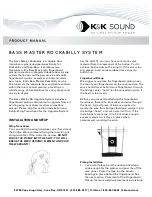
Setup
1.
Choose the power source.
Before using the PHH-SD1, be sure it is powered by fresh
batteries or an optional 9VDC AC adapter plugged into the bottom jack on its right side
(callout 1-15).
To remove the battery compartment cover, remove the two screws holding it in place (callout
1-11). Then install six AA batteries in the correct orientation, using the polarity marks on the
inside of the compartment as a guide. Replace the cover by replacing the two screws.
2.
Install an SD card.
To prepare for setup, also install the supplied 2 GB SD memory card
or another card with a capacity from 1 GB to 16 GB in the socket on the bottom of the
PHH-SD1 (callout 1-18). When installing the card, make sure its gold contacts are facing
front and push the card into the socket until you hear a click. To remove the card, push it
in until you hear a click and the card pops out.
Now power on the instrument by pressing the POWER button (callout 1-2) to generate a short
beep. (To power off the PHH-SD1, press the POWER button and hold it until the instrument
responds with a long beep.)
When the meter powers on, a series of transient startup screens will briefly appear. Once the
display has stabilized, perform the following eight setup steps in the order presented.
3.
Format the SD card.
LOGGER SET button (callout 1-8) and hold it for at least five
seconds, until “Sd-F” appears in the lower half of the display. Quickly (within three
seconds) press the REC/ENTER button.
(If you press buttons too slowly in setup mode, the screen will revert to the normal display. To
return to the setup sequence, press and hold the LOGGER SET button again. To move ahead to
the next field in the sequence or to the next parameter, press the HOLD/ESC button.)
Pressing the REC/ENTER button causes the word “no” or “yES” to appear over the term
“Sd-F”. Press the
▼
button to make a selection. Choose “yES” whenever a new SD card
is being used, or when a used card is being repurposed (from use with another SD card
instrument or a camera, for example) and all data on it is to be erased. Choose “no” to
preserve any data on a card previously used with this instrument.
If you choose “yES”, after you press the REC/ENTER button the instrument will prompt
you to confirm that decision by displaying the term “Ent” below “yES” and sounding
three beeps. To confirm that you want to begin the erasure/formatting procedure, press
the REC/ENTER button. “Ent” will then flash several times and the instrument will
sound another three beeps to confirm that the SD card has been erased and formatted.
4.
Set the date and time.
Once the SD card has been formatted (or not), the meter will
automatically move to the next step in the startup sequence: setting the current date and
time. When the word “dAtE” appears in the center of the display, along with the flashing
value “00.00.00” at the lower left, above “yy.mm.dd”, set the current year by pressing the
▼
or
▲
button repeatedly until the correct value appears above “yy”. Press the
REC/ENTER button to store the setting. The next screen that appears will have the value
above “mm” flashing. Use the
▼
or
▲
button to navigate to the current month and press
the REC/ENTER button to store the setting. When the next screen flashes the value
3

































